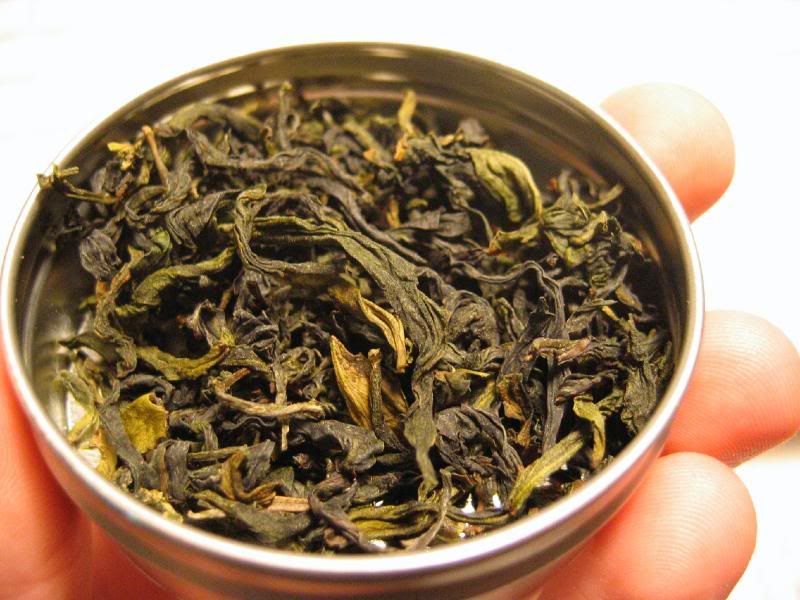
As the title suggests, this Fukamushi isn't as good as the last one I reviewed from Rishi. This fuka is from Hibiki-an, which is a very good supplier, but lacking in this tea. I was attracted to Hibiki-an for many reasons, they not only ship direct from Japan, but they are a tea farm in Japan, shipping out their very own teas, which they can supply at a low price. Also, an enthusiast very well versed in Japanese teas recommended I try some of their teas. In addition to ordering this enthusiasts favorite (Sencha Karigane), I also decided to try one of their fukamushis, Sencha Fukamushi Superior, at $22 for 200 grams, it's quite a bargain.
A positive note for Hibiki-an is their packaging:




That is one purchase of 200g of Sencha Karigane in two seperate bags, and one purchase of 200g of Sencha Fukamushi Superior.
Of course I got overly excited about the fukamushi, which turned out to be not as good, letting me down :(
The dry product looked very similar to Rishi's fuka:


The smell of the leaf was slightly tart (during my next review will become clear that this "tartness" is a key characteristic of the Karigane), very sweet, with a deep, dark grassiness. The tart smell concerned me because I it could be a sign of contamination of the Karigane into the fuka. But, the tasting went on...
Weapon of Choice: Fukugata

3.5-4 teaspoons for 300ml, the same parameters as for Rishi's fuka, gave me this:


Even with it being the first steeping, the wet product was just not that green, not that full.
The wet leaves were fairly good-looking, but they still have some unhealthy-brown leaves placed throughout:


The cool thing is that one of my preferred cups holds the Fukugata's volume exactly:

The aroma of the tea is very sweet, containing more vegetal notes than grassy ones. The tart from the dry leaf smell is still concerningly present (as an undertone).
The taste of the hot tea is predominantly sweet, accompanied by slight vegetal on top of the tongue, and slight grassiness on the sides of the tongue. Once the tea cools down to a warm-hot temperature, it develops a deeper sweetness with more vegetalness on the top, yet still a noticeable grassiness on the sides. By the time the tea has reached a warm-warm temp, I've lost much of my interest. The tea becomes much more "watery," depicting a loss of desirable flavors. I noticed during this drinking, that when the sediment in the bottom of the cup gets mixed back up into the tea, then a deep sweetness again dominates the flavor of the tea. This is a note to always mix the bits back up into the tea, it allows one to become more intimate with the tea, bringing up flavors that may normally be missed. On a good note, the tartness did not come out in the flavor of the tea, meaning that it was just a contamination of aroma, not actual tea. I'm curious as to what has caused this...
The second steeping was much more aesthetically pleasing, holding a greater opaqueness and a sweeter flavor:




Much better looking indeed :)
The aroma coming from the second steeping was sweeter, less complex, yet still more vegetal than grass. When the tea is hot, the taste is sweet, yet more noticeably grassy. As the temperature lowers, the grassy taste is overtaken by the vegetal-sweetness.
In conclusion, this tea is not as flavorful as Rishi's Fukamushi, even when steeped to the verge of bitterness.
As I unenthusiastically finish the cup, I'm swamped by thoughts of how much better this tea is when combined with a large amount of the Sencha Karigane (which is the best mixture I have devised, and will write a review of soon).
This may just be a case of "not my cup of tea," but I truly believe that this is a fukamushi of lesser quality, and at $22 for 7oz, this is easily conceivable.
On a closing note, I have decide to submerse myself into the world of Pu-erh. For what reasons, I am not entirely sure. I have planned to document my coming into the pu-erh world in a blog, yet I am again irresolute. Should I chronicle my pu-erh tastings and reviews in this blog, or shall I create a new one, specialized for my beginnings of pu-erh, which would eventually show my whole journey through the pu-erh, becoming increasingly more sophisticated and complex. I rather admire the theme that a "Newbie Pu-erh" blog would give, yet it would also be simpler to have enerything in one place...

























































